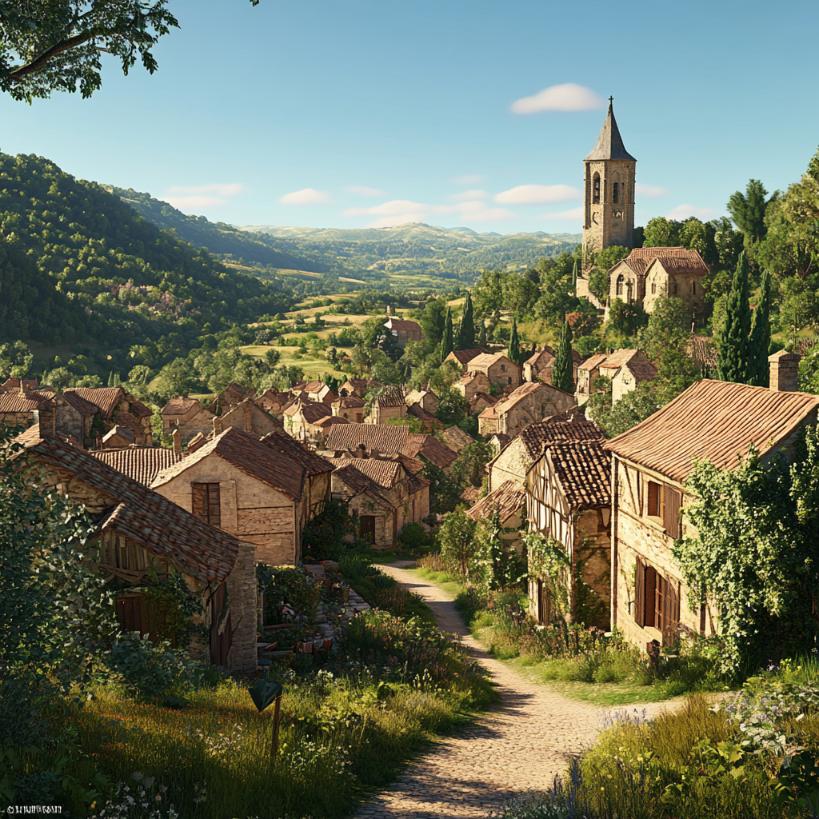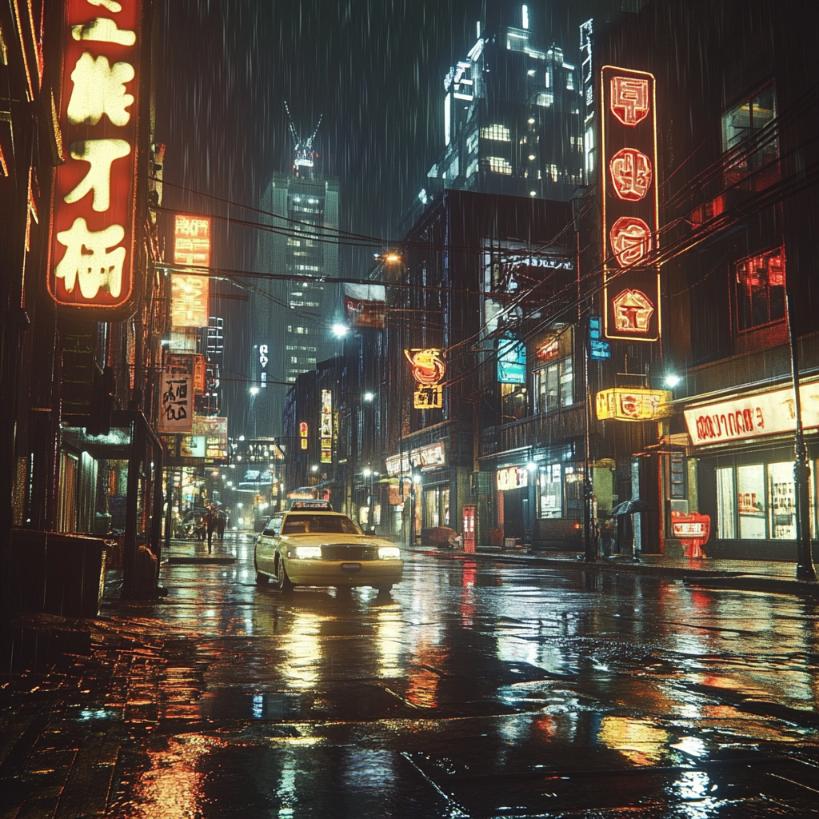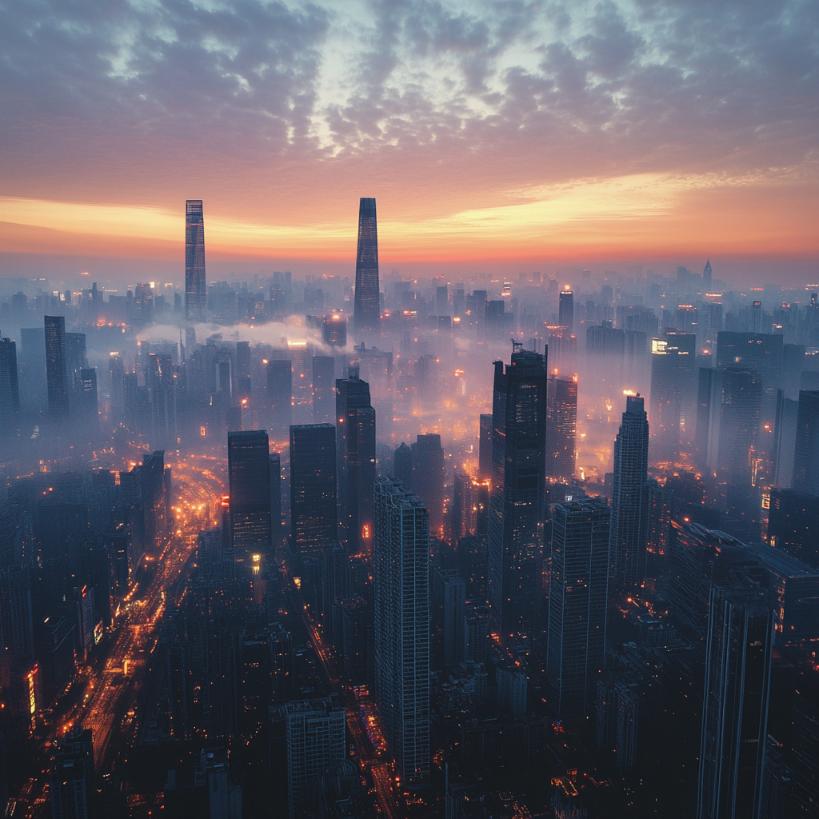Establishing Shot: The Foundation of Visual Storytelling
Introduction:
An establishing shot is a wide or distant shot that introduces the setting of a scene, providing the audience with the necessary context about where and when the action is taking place. Typically, this shot captures a broad view of the environment, such as a city skyline, a sweeping landscape, or an exterior of a building, to give viewers a sense of location before focusing on the more detailed action within the scene.
The importance of an establishing shot in film and video production cannot be overstated. It serves as the audience’s first visual clue, helping them orient themselves within the story. By setting the scene, an establishing shot establishes the mood, atmosphere, and sometimes even the thematic undertones of the narrative. It acts as a visual shorthand, allowing viewers to understand the context without needing additional explanation, thereby enhancing the storytelling process.
Moreover, establishing shots play a crucial role in setting the tone for what is to come. Whether it’s the eerie calm of an abandoned town or the bustling energy of a city during rush hour, these shots prepare the audience for the emotional journey they are about to embark on. By effectively using establishing shots, filmmakers can subtly guide the audience’s expectations, drawing them deeper into the story from the very first frame.
What is an Establishing Shot?
An establishing shot is a foundational element in visual storytelling, often used at the beginning of a scene to provide the audience with a clear understanding of the setting. It is typically a wide or long shot that captures a broad view of the environment, offering essential visual information about the location, time, and context in which the upcoming scene will unfold. The establishing shot is the cinematic equivalent of opening the curtains on a stage, revealing the backdrop against which the story will play out.
Types of Establishing Shots
Wide Shots:
- Definition: Wide shots, also known as long shots, are the most common form of establishing shots. They encompass a large area, showing the setting in its entirety.
- Example: A wide shot of a desert landscape with a solitary figure walking in the distance sets the scene for a story of survival and solitude.
Aerial Views:
- Definition: Aerial views, often captured by drones or helicopters, provide a bird’s-eye perspective of a location. These shots are particularly effective in showcasing the scale and scope of a setting.
- Example: An aerial shot of a bustling metropolis from above, with cars moving like tiny specks, gives viewers an immediate sense of the city’s size and energy.
Exterior Building Shots:
- Definition: This type of shot focuses on the exterior of a significant building or structure, giving context to the interior scenes that follow.
- Example: A shot of a grand, imposing mansion at dusk, with lights flickering on inside, sets the tone for a narrative filled with intrigue and mystery.
Landscape Shots:
- Definition: Landscape shots highlight the natural environment, often used in genres like westerns, fantasy, and adventure films to establish a vast, untamed setting.
- Example: A sweeping shot of snow-capped mountains under a clear blue sky instantly transports the audience to a remote, wilderness setting.
Setting Location, Time, and Mood
An establishing shot does more than just show where a scene takes place; it also conveys the time of day and sets the mood for the upcoming action. For instance, a wide shot of a city bathed in the golden light of dawn not only informs the audience that it is morning but also evokes a sense of renewal and possibility. On the other hand, the same city shown at night, with neon lights reflecting off wet streets, might set a mood of tension or foreboding.
By establishing the location, time, and mood, these shots anchor the audience in the story’s world. They provide a visual foundation that helps viewers immerse themselves in the narrative, making it easier to follow the unfolding events. In this way, establishing shots are not just about setting the stage; they are about crafting the emotional and contextual framework that supports the entire story.
Importance of the Establishing Shot in Filmmaking

The establishing shot is a critical tool in filmmaking, serving as a cornerstone for narrative clarity. Its primary purpose is to provide the audience with a clear understanding of the setting, which in turn helps them to orient themselves within the story. By delivering essential visual cues about where the action is taking place, establishing shots ensure that the narrative is coherent and easy to follow.
Crucial for Narrative Clarity
One of the most significant roles of an establishing shot is to eliminate confusion. In a film or video, scenes often shift from one location to another, sometimes rapidly. Without an establishing shot, viewers may struggle to understand where the characters are or how the scenes relate to one another. This can lead to disorientation and detract from the overall storytelling experience. By clearly introducing the setting at the start of a scene, an establishing shot provides the necessary context that ties the narrative together, making it more accessible and engaging.
Orienting the Audience and Providing Visual Context
Establishing shots work as a visual anchor, grounding the audience in the story’s world. This is particularly important in complex narratives where the action shifts between multiple locations or time periods. For example, a film that alternates between a character’s past and present might use establishing shots of the same location at different times of the day or in different weather conditions to signify these shifts. This not only helps the audience understand where and when the scene is taking place but also allows them to focus on the unfolding drama without unnecessary distractions.
Moreover, establishing shots often carry thematic weight, subtly communicating the tone or mood of the scene. For instance, an establishing shot of a sunny, bustling city street might convey a sense of normalcy or optimism, while a similar shot of the same street at night, with rain-soaked pavement and shadowy figures, might evoke tension or danger. By setting the emotional tone early, the establishing shot prepares the audience for the kind of story they are about to witness.
Examples from Popular Films
Establishing shots are used effectively in many iconic films to create memorable and impactful scenes:
“Blade Runner” (1982):
- The film opens with an iconic establishing shot of a dystopian Los Angeles in 2019. The aerial view of the city, filled with towering skyscrapers, smog, and the glow of neon lights, immediately sets the tone for a dark, cyberpunk narrative. This shot not only introduces the setting but also conveys the oppressive and bleak atmosphere that permeates the entire film.
“The Shining” (1980):
- In Stanley Kubrick’s “The Shining,” the establishing shot of the Overlook Hotel, nestled in the remote Colorado mountains, plays a crucial role in the film’s unsettling atmosphere. The wide shot of the isolated hotel surrounded by snow-capped peaks conveys a sense of isolation and foreboding, which is central to the horror that unfolds.
“Lawrence of Arabia” (1962):
- David Lean’s epic film “Lawrence of Arabia” uses expansive establishing shots of the desert to emphasize the vastness and harshness of the landscape. The opening shot of endless sand dunes, with the tiny figure of Lawrence riding across them, sets the stage for a story of epic adventure and struggle against overwhelming odds.
“Inception” (2010):
- Christopher Nolan’s “Inception” uses establishing shots to distinguish between different layers of dreams. For instance, the initial wide shot of the snow-covered fortress in the third dream layer helps the audience quickly understand the new environment, differentiating it from the previous dream layers and aiding in the complex narrative structure.
These examples illustrate how establishing shots are more than just a technical requirement; they are a powerful storytelling device. By providing clarity, context, and emotional resonance, they enhance the audience’s experience, making the narrative more compelling and immersive.
How to Create an Effective Establishing Shot
Creating an effective establishing shot requires careful planning and attention to detail. The goal is to craft a shot that not only introduces the setting but also enhances the story by setting the mood and context. Here are some tips and techniques to help you create impactful establishing shots:
Tips and Techniques for Shooting an Establishing Shot
-
Choose the Right Location:
- The location you select for your establishing shot should be visually compelling and relevant to the story. It should convey key information about the setting, such as the time period, geography, and cultural context. Spend time scouting locations that can visually represent the essence of the scene you are about to introduce.
-
Use Wide or Long Shots:
- Establishing shots are typically captured using wide or long shots that encompass a large portion of the setting. This allows the audience to take in the entire scene, gaining a clear understanding of where the action will take place. When framing the shot, consider the elements you want to include in the composition to provide as much visual information as possible.
-
Incorporate Movement:
- Adding movement to your establishing shot can make it more dynamic and engaging. Techniques like panning, tilting, or using a tracking shot can introduce the setting in a fluid and cinematic way. For example, a slow pan across a city skyline at dusk can gradually reveal the environment, building anticipation for the scene that follows.
-
Consider the Time of Day:
- The time of day can significantly impact the mood of your establishing shot. Shooting at golden hour (just after sunrise or before sunset) provides soft, warm lighting that can add a sense of calm or nostalgia. Conversely, shooting at night with artificial lighting can create a sense of mystery or tension. Choose the time of day that best aligns with the tone of your narrative.
-
Pay Attention to Details:
- Even though an establishing shot is often wide, small details can add depth and richness to the scene. For instance, including people or objects in the foreground can create a sense of scale and place. Look for elements that can subtly reinforce the story, such as a weathered sign in a small town, or the lights of passing cars in a bustling city.
Considerations for Camera Angles, Lighting, and Composition
-
- The angle from which you shoot your establishing shot can dramatically influence how the audience perceives the setting. A high-angle shot can make a location appear vast and imposing, while a low-angle shot can emphasize the grandeur or intimidation of a structure. Consider how the angle aligns with the story’s theme—whether it’s to evoke awe, fear, or familiarity.
-
Lighting:
- Lighting plays a crucial role in establishing the mood of the shot. Natural light often provides a realistic and relatable feel, while artificial or stylized lighting can create a more controlled and specific atmosphere. For example, harsh, direct sunlight can highlight the desolation of a barren landscape, while soft, diffused light can make a setting feel inviting and serene.
-
Composition:
- Composition is key to making an establishing shot visually appealing and informative. Use techniques like the rule of thirds to place key elements within the frame, guiding the viewer’s eye to important aspects of the scene. Symmetry, leading lines, and framing can also be used to draw attention and create a sense of balance or tension within the shot.
The Role of Establishing Shots in Different Genres
-
Horror:
- In horror films, establishing shots are often used to create a sense of unease or foreboding. A shot of an isolated, decrepit house in the middle of a dark forest can immediately set a chilling tone. The use of low lighting, fog, or stark contrasts can amplify the eerie atmosphere, making the setting itself feel like a character in the story.
-
Drama:
- In drama, establishing shots often focus on the emotional context of the setting. A bustling café in the heart of a city can symbolize the loneliness of a character in a crowded place, while a serene countryside can reflect inner peace or isolation. The composition and lighting in drama often aim to evoke specific emotions that resonate with the audience.
-
Action:
- In action films, establishing shots are used to quickly convey the scope and stakes of the scene. A wide shot of a city before a high-speed chase or a vast battlefield before a climactic fight sets the stage for the adrenaline-pumping action to follow. These shots are often dynamic, with bold compositions and dramatic lighting to enhance the sense of urgency and excitement.
Establishing shots are not just about setting the scene—they are about setting the stage for the story to unfold. By carefully considering camera angles, lighting, composition, and the specific needs of your genre, you can create establishing shots that not only inform but also captivate and engage your audience.
Common Mistakes to Avoid

While establishing shots are a powerful tool in filmmaking, they can sometimes be misused or overlooked, leading to a less effective narrative. Understanding common mistakes filmmakers make when using or omitting establishing shots can help you avoid pitfalls and ensure that your establishing shots add real value to your story.
Mistake 1: Skipping the Establishing Shot
One of the most common mistakes is completely omitting an establishing shot, especially in scenes where the location or time is crucial to the audience’s understanding of the narrative. Without an establishing shot, viewers may become disoriented, unsure of where the action is taking place or how the scene fits into the overall story. This can lead to confusion and disengagement, weakening the impact of the scene.
How to Avoid It:
Always consider whether an establishing shot is necessary to orient your audience. If your scene is shifting to a new location or time period, an establishing shot can provide the context needed to smoothly transition from one part of the story to the next. Even a brief establishing shot can make a significant difference in maintaining narrative clarity.
Mistake 2: Overusing Establishing Shots
On the other end of the spectrum, some filmmakers overuse establishing shots, placing them before every new scene or transition. While this might seem like a way to ensure clarity, it can slow down the pacing of the film and make the story feel repetitive or overly structured. Overusing establishing shots can also diminish their impact, making them feel more like a routine rather than a deliberate storytelling choice.
How to Avoid It:
Use establishing shots strategically, only when they add necessary information or enhance the story. Consider whether the audience already understands the setting or if additional context is required. Sometimes, a scene can begin with a more intimate shot that gradually reveals the setting, allowing for a more dynamic and engaging introduction.
Mistake 3: Using Generic or Uninspired Shots
Another mistake is relying on generic or uninspired establishing shots that don’t contribute meaningfully to the story. A bland, uninteresting shot of a location might provide the necessary context, but it won’t engage the audience or add depth to the narrative. If the establishing shot doesn’t connect emotionally with the audience or visually stand out, it can feel like a missed opportunity.
How to Avoid It:
Treat each establishing shot as a chance to enhance the storytelling. Think about how you can frame the shot to reflect the mood, theme, or tone of the scene. Consider using unique angles, interesting lighting, or movement to make the shot more visually compelling. An establishing shot should do more than just show the location—it should evoke a feeling or hint at the story’s direction.
Mistake 4: Failing to Match the Tone of the Scene
A mismatched establishing shot can jar the audience and disrupt the flow of the narrative. For example, an establishing shot that is too bright and cheerful for a scene meant to be tense and suspenseful can create a dissonance that pulls viewers out of the story. The tone of the establishing shot should align with the mood and atmosphere of the scene it introduces.
How to Avoid It:
Ensure that the tone of your establishing shot matches the emotional and narrative tone of the scene that follows. Pay attention to the lighting, color palette, and composition to create a shot that seamlessly leads into the next part of the story. If the scene is dark and mysterious, the establishing shot should reflect that, preparing the audience for what’s to come.
Mistake 5: Ignoring the Role of Sound
While the focus of an establishing shot is often on the visual elements, sound plays a crucial role in setting the scene as well. A beautiful establishing shot can lose impact if accompanied by inappropriate or poorly mixed sound. For example, a tranquil forest scene might be disrupted by harsh, unrelated sounds, breaking the immersion for the audience.
How to Avoid It:
Pay close attention to the sound design of your establishing shots. Use ambient sounds, music, or even silence to enhance the mood and tone of the shot. The right sound can deepen the emotional impact and help draw the audience into the world you’re creating. Consider how sound interacts with the visuals to create a cohesive and immersive experience.
Ensuring the Establishing Shot Adds Value to the Narrative
To make sure your establishing shots add value to the narrative, approach them with intention and creativity. Every establishing shot should serve a purpose beyond simply showing the setting. Ask yourself how the shot contributes to the story—does it set the mood, provide crucial context, or foreshadow events to come? By thoughtfully integrating establishing shots into your film, you can enhance the storytelling, engage your audience, and create a more immersive cinematic experience.
Remember, an effective establishing shot is one that resonates with the audience, drawing them into the story and making them feel like they are part of the world you’ve created.
Conclusion
The establishing shot is a powerful tool in visual storytelling, serving as the gateway into the world of a film or video. It sets the stage, providing crucial context about the location, time, and mood of a scene, which in turn helps orient the audience and enhances narrative clarity. Whether it’s the vast expanse of a desert, the bustling streets of a city, or the eerie stillness of a haunted house, the establishing shot is key to immersing viewers in the story from the very first frame.
By carefully considering the composition, lighting, and tone of your establishing shots, you can create scenes that are not only visually stunning but also deeply connected to the narrative. These shots have the potential to evoke emotions, foreshadow events, and subtly guide the audience’s expectations, making them an indispensable part of effective filmmaking.
As filmmakers, it’s important to experiment with different types of establishing shots to discover what best serves your story. Don’t be afraid to think creatively—try new angles, play with lighting, and explore how sound can enhance the visual experience. Each film presents unique opportunities to use establishing shots in ways that surprise, engage, and captivate your audience.
In the end, the establishing shot is more than just a functional aspect of filmmaking; it’s an artistic tool that can elevate your storytelling to new heights. By mastering this technique, you’ll be able to craft more compelling, immersive narratives that resonate with viewers long after the credits roll.

